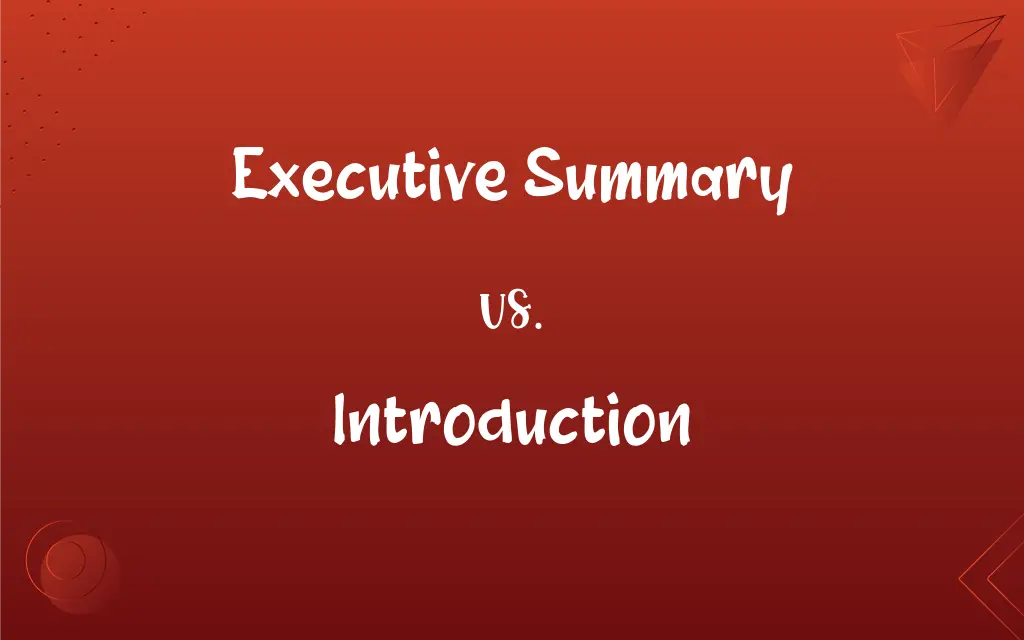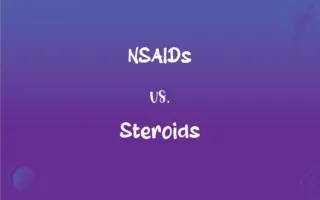Executive Summary vs. Introduction: What's the Difference?
Edited by Aimie Carlson || By Harlon Moss || Updated on October 6, 2023
An executive summary provides a condensed version of content, highlighting key points, while an introduction generally outlines the purpose and scope of the content that follows.

Key Differences
An executive summary distills the key points, findings, and recommendations of a longer report or proposal into a shorter overview. The executive summary is particularly crucial in business and research contexts, where readers may not have the time to peruse the full document and are looking for quick insights or information that is pertinent to their decision-making process. It essentially stands alone, providing the essence of the content, often for decision-making purposes. Introductions, on the other hand, provide a foundational explanation or background to guide through the subsequent content.
The introduction serves to present the background, context, and purpose of the document or piece of writing. It is meant to orient the reader and provide a roadmap or guideline for what to expect in the coming sections. Unlike the executive summary, it does not reveal key findings or recommendations but rather introduces the topic and provides context. An introduction is not standalone; it is intricately linked to the detailed content that follows.
While both the executive summary and the introduction are integral parts of a report or document, they serve distinct purposes and are utilized differently by the reader. The executive summary, generally, should be able to be read independently and provide a coherent understanding of the overall document without requiring the reader to delve into the full text. It is often considered the most important section of a business plan or report, providing busy executives with a quick overview and potentially influencing whether they decide to read further.
The introduction, conversely, does not offer a holistic view of the overall document. It presents the necessary background and purpose to contextualize the ensuing content, helping to guide the reader's understanding as they move through the document. It should stimulate the reader’s interest and provide them with enough context to understand the following sections but not reveal all the key information or findings.
In summary, the executive summary condenses and presents the critical points, findings, and recommendations from a larger document, aiming to provide a comprehensive overview in a succinct format. In contrast, an introduction sets the stage for the content that will follow, providing background, context, and purpose without unveiling key outcomes or conclusions.
ADVERTISEMENT
Comparison Chart
.
A brief and condensed version of the main text
Explains the reason for which the text is about and why is it written
Length
Relatively longer
Relatively shorter
Contains
All important elements, recommendations, and conclusions
Background information, thesis statement, aims, the definition of terms
Separate Document
Can be
Cannot be
Purpose
To summarize key points, findings, and recommendations.
To provide background and context without revealing key findings.
ADVERTISEMENT
Independence
Can be read and understood independently of the full text.
Cannot stand alone and is intricately tied to subsequent content.
Audience
Aimed at decision-makers who may not read the full document.
Intended for all readers to provide context and background.
Content
Includes key findings and recommendations.
Does not include main findings or recommendations.
Executive Summary and Introduction Definitions
Executive Summary
A short segment that provides a comprehensive overview and recommendations from the main text.
The executive summary presented three main recommendations for consideration.
Introduction
The initial section that outlines the purpose and scope of a document.
The introduction clearly stated the objectives of the research.
Executive Summary
A document aimed primarily at decision-makers providing key information.
The executive summary targeted the CEO, providing crucial data upfront.
Introduction
A segment that provides background information and context without revealing key findings.
Readers found the introduction helpful in understanding the document’s context.
Executive Summary
A brief section that encapsulates the main points and findings of a larger document.
The research’s primary insights were detailed in the executive summary.
Introduction
A section that aims to spark interest and provide initial information without summarizing.
The introduction captivated readers’ interest with engaging questions.
Executive Summary
A standalone document providing insights without requiring reading of the full text.
Decision-makers often only read the executive summary due to time constraints.
Introduction
A prelude that sets the stage for the subsequent content.
The introduction provided a foundation for understanding the upcoming sections.
Executive Summary
A condensed version of a larger document highlighting key points.
The executive summary succinctly outlined the proposal’s main recommendations.
Introduction
A portion that establishes the topic without discussing outcomes or conclusions.
The introduction familiarized readers with the topic but not the findings.
Introduction
The act or process of introducing or the state of being introduced.
Introduction
A means, such as a personal letter, of presenting one person to another.
Introduction
Something recently introduced; an innovation
"He loathed a fork.
It is a modern introduction which has still scarcely reached common people" (D.H. Lawrence).
FAQs
Is the introduction vital for understanding the context of a document?
Yes, the introduction provides necessary background and context to guide readers through the subsequent content.
How is an introduction different from an executive summary in content?
An introduction provides background and sets the stage without revealing key findings, while an executive summary summarizes key points and findings.
What is the primary purpose of an executive summary?
To provide a brief and comprehensive overview of the key points and findings of a larger document.
Who is the primary audience for an executive summary?
Generally, decision-makers and individuals who may not have the time to read the full document.
Does the introduction reveal the conclusions of the document?
No, the introduction provides background and context without unveiling key findings or conclusions.
What information is typically included in an introduction?
Background information, context, and a guideline of what to expect in the upcoming content, without revealing key findings.
Is it appropriate to use bullet points in an executive summary?
Yes, bullet points can effectively highlight key points, making the text easily scannable and digestible for readers.
Can the introduction include questions?
Yes, posing questions can pique interest, frame the content, and guide reader expectations.
Can an introduction be engaging and intriguing?
Absolutely, an engaging introduction captures the reader’s interest and encourages them to read further.
Should recommendations be included in the executive summary?
Yes, the executive summary should encapsulate key recommendations and findings from the main text.
How does the introduction relate to the document's body?
The introduction provides a foundation and context that help the reader understand and navigate through the main content of the document.
Should an executive summary be on its own page?
Often yes, especially in formal reports or business plans, to emphasize its independence and facilitate quick reading.
What tense is typically used in an executive summary?
Generally, the present tense, although past tense may be used for discussing specific findings or completed actions.
Is it necessary to read both the executive summary and the full document?
Not always. The executive summary should provide sufficient insight for those lacking the time to read in full, but reading both provides a deeper understanding.
How long should an introduction be?
Long enough to sufficiently introduce the topic and provide context, without being overly detailed or revealing key outcomes.
Can an executive summary include visuals?
Yes, visuals like graphs or charts can be utilized if they effectively convey key points in a succinct manner.
How should an executive summary be formatted?
Clearly and concisely, often utilizing headers, bullet points, and short paragraphs to enhance readability and scannability.
Can an executive summary be read independently of the full document?
Yes, an executive summary is designed to provide a coherent overview without requiring the reader to explore the full document.
How detailed should an executive summary be?
Detailed enough to convey key findings, recommendations, and essential information from the main document, while still being succinct.
Is it necessary to include keywords in the introduction?
Including keywords can enhance clarity and focus, ensuring that the reader understands the main topics or themes that will be explored.
About Author
Written by
Harlon MossHarlon is a seasoned quality moderator and accomplished content writer for Difference Wiki. An alumnus of the prestigious University of California, he earned his degree in Computer Science. Leveraging his academic background, Harlon brings a meticulous and informed perspective to his work, ensuring content accuracy and excellence.
Edited by
Aimie CarlsonAimie Carlson, holding a master's degree in English literature, is a fervent English language enthusiast. She lends her writing talents to Difference Wiki, a prominent website that specializes in comparisons, offering readers insightful analyses that both captivate and inform.































































